AWS Certified SysOps Administrator - Associate
Domain 1 Monitoring Logging and Remediation
Demo Creating and Executing Automation Runbooks
Welcome to our SSM Automation tutorial. In this lesson, Michael Forrester demonstrates how to use a CloudFormation template to launch a T2 micro EC2 instance and configure SSM automation documents. These documents later create snapshots and restart the instance. Follow along as we explore the details of the CloudFormation template, IAM role configuration, and runbook creation.
CloudFormation Template Overview
The CloudFormation template provisions several key resources, including the EC2 instance, the instance profile, and the necessary IAM roles. The instance is configured to run the latest Amazon Linux 2 AMI and ensures that the SSM agent is properly installed and running.
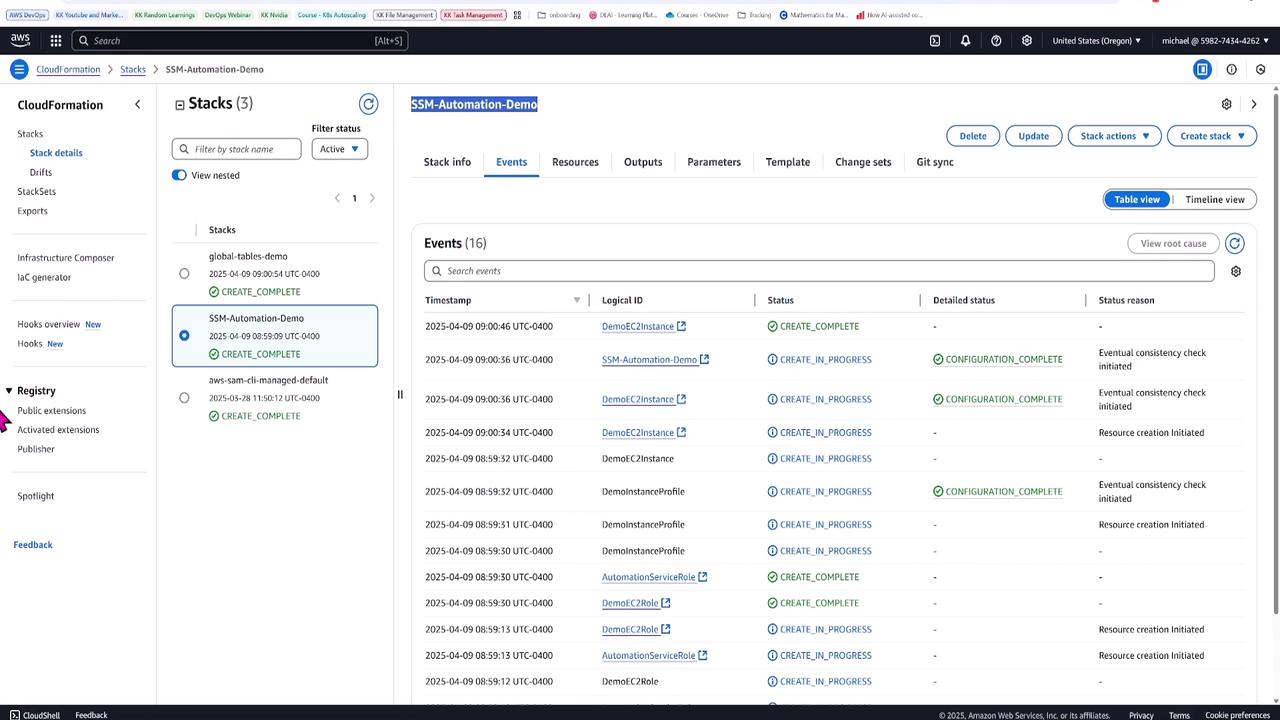
Below is an excerpt of the CloudFormation template:
Type: String
Default: t2.micro
Description: EC2 instance type
AllowedValues:
- t2.small
- t3.micro
- t3.small
Resources:
DemoEC2Instance:
Type: AWS::EC2::Instance
Properties:
ImageId: '{{resolve:ssm:/aws/service/ami-amazon-linux-latest/amzn2-ami-hvm-x86_64-gp2}}'
InstanceType: !Ref InstanceType
IamInstanceProfile: !Ref DemoInstanceProfile
UserData:
Fn::Base64: |
#!/bin/bash
# Ensure the SSM agent is installed and running
sudo systemctl status amazon-ssm-agent
if [ $? -ne 0 ]; then
sudo yum install -y amazon-ssm-agent
sudo systemctl enable amazon-ssm-agent
sudo systemctl start amazon-ssm-agent
fi
# Log installation status for verification
echo "SSM Agent installation status:" > /tmp/ssm-install-log.txt
sudo systemctl status amazon-ssm-agent >> /tmp/ssm-install-log.txt
Tags:
- Key: Name
Value: SSM-Automation-Demo-Instance
DemoInstanceProfile:
Type: AWS::IAM::InstanceProfile
Properties:
Roles: !Ref DemoEC2Role
Note
The template includes a user data script to validate that the SSM agent is running on the instance, ensuring seamless automation execution.
IAM Role Configurations
The template defines two critical IAM roles. One is for the EC2 instance (DemoEC2Role) to enable SSM managed instance functionality, and the other is the Automation Service Role, which allows the automation document to perform a series of EC2 actions.
AssumeRolePolicyDocument:
Version: '2012-10-17'
Statement:
- Effect: Allow
Principal:
Service: ec2.amazonaws.com
Action: sts:AssumeRole
ManagedPolicyArns:
- arn:aws:iam::aws:policy/AmazonSSMManagedInstanceCore
AutomationServiceRole:
Type: AWS::IAM::Role
Properties:
AssumeRolePolicyDocument:
Version: '2012-10-17'
Statement:
- Effect: Allow
Principal:
Service: ssm.amazonaws.com
Action: sts:AssumeRole
ManagedPolicyArns:
- arn:aws:iam::aws:policy/service-role/AmazonSSMAutomationRole
Policies:
- PolicyName: EC2ManagementPermissions
PolicyDocument:
Version: '2012-10-17'
Statement:
- Effect: Allow
Action:
- ec2:DescribeInstances
- ec2:DescribeInstanceStatus
- ec2:StartInstances
- ec2:StopInstances
- ec2:CreateSnapshot
- ec2:DescribeSnapshots
- ec2:CreateTags
Resource: '*'
Outputs:
InstanceId:
Description: ID of the EC2 instance.
The CloudFormation template reiterates the tags and instance profile configuration to ensure consistency:
Tags:
Key: Name
Value: SSM-Automation-Demo-Instance
DemoInstanceProfile:
Type: AWS::IAM::InstanceProfile
Properties:
Roles:
- !Ref DemoEC2Role
DemoEC2Role:
Type: AWS::IAM::Role
Properties:
AssumeRolePolicyDocument:
Version: '2012-10-17'
Statement:
- Effect: Allow
Principal:
Service: ec2.amazonaws.com
Action: sts:AssumeRole
ManagedPolicyArns:
- arn:aws:iam::aws:policy/AmazonSSMManagedInstanceCore
AutomationServiceRole:
Type: AWS::IAM::Role
Properties:
AssumeRolePolicyDocument:
Version: '2012-10-17'
Statement:
- Effect: Allow
Principal:
Service: ssm.amazonaws.com
Navigating to AWS Systems Manager
Once the instance and IAM roles are provisioned through CloudFormation, the next step is to work within AWS Systems Manager. Navigate to the Documents section under Change Management Tools to create a custom automation document.
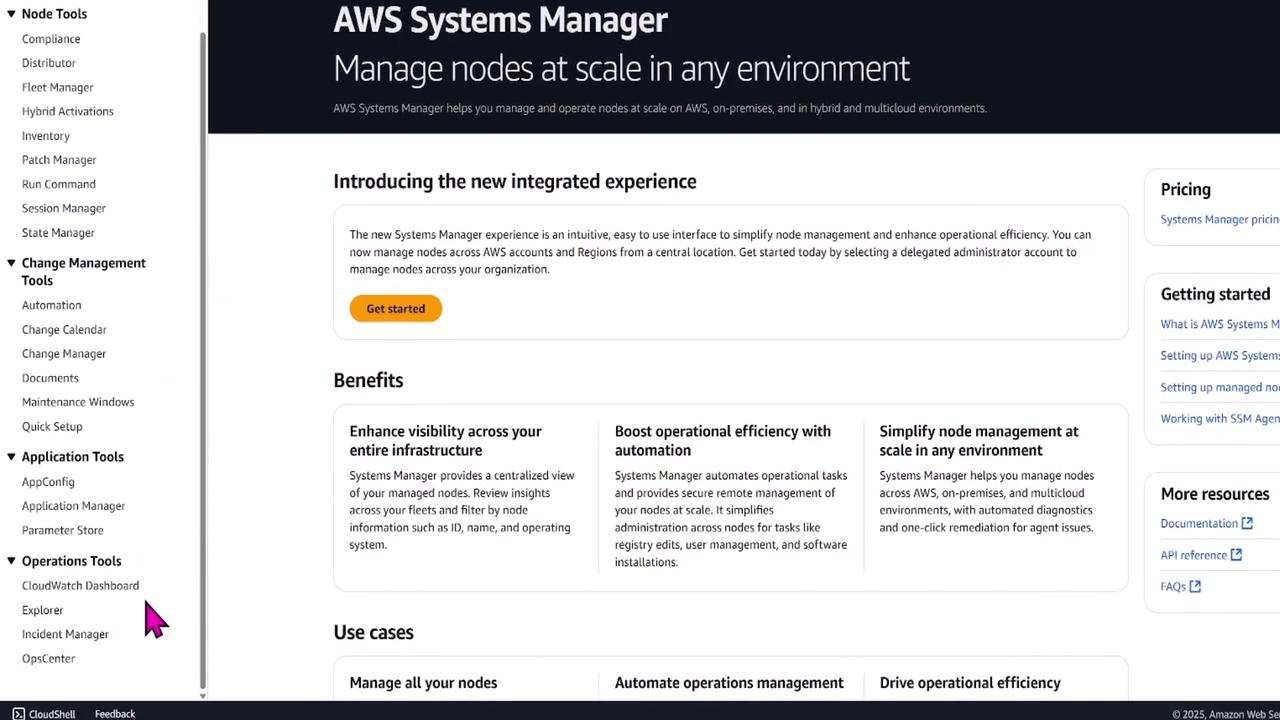
Click on Documents and choose to create a new document with the Automation type. Follow the on-screen guide to start with automation runbooks.
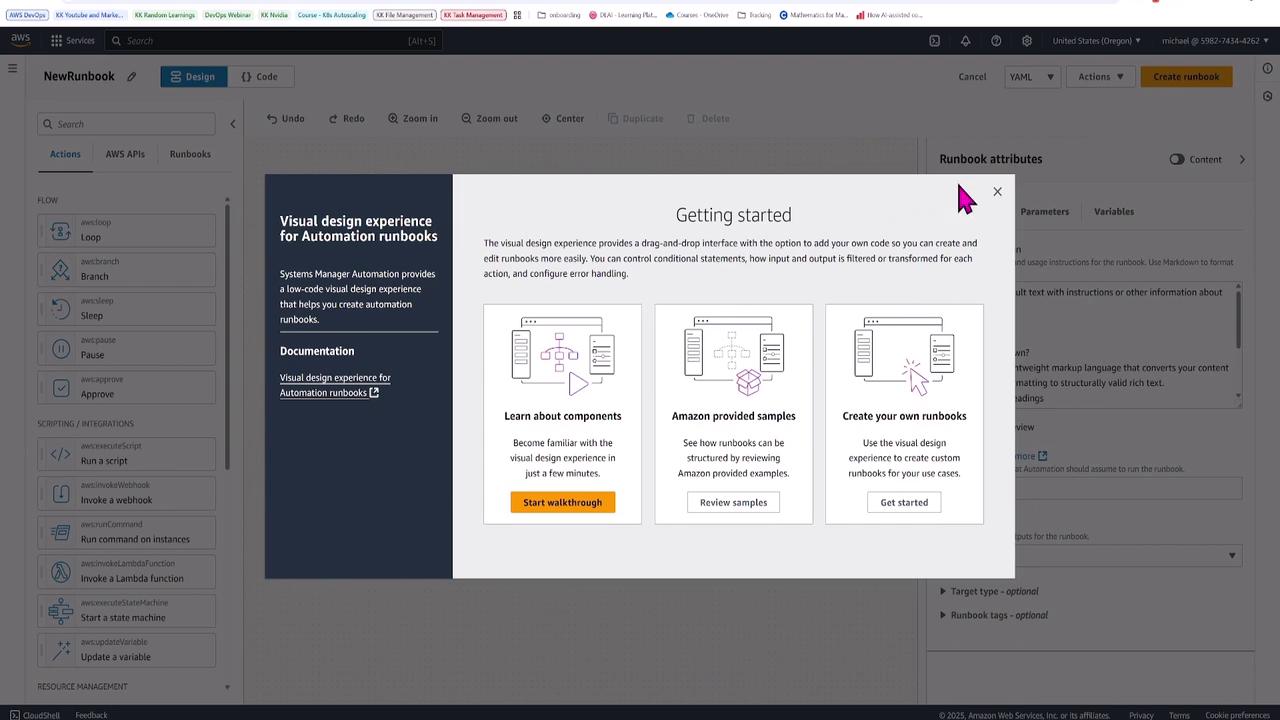
Designing the Automation Runbook
For this runbook, name it StopSnapshotStartEC2Instance. This document performs the following tasks:
- Stops the EC2 instance.
- Creates a snapshot of its root volume.
- Starts the instance.
- Verifies that the instance is in a running state.
The automation flow is visually represented using a flowchart interface.

Switch to the code view to review and customize the runbook. A pre-configured runbook using schema version 3 is provided:
schemaVersion: '0.3'
description: |
*Replace this default text with instructions or other information about your runbook.*
----
### What is Markdown?
Markdown is a lightweight markup language that converts your content with plain text formatting to structure.
## You can add headings
You can add *italics* or make the font **bold**
1. Create numbered lists
2. Add bullet points
* Indent code samples
You can create a [link to another webpage](https://aws.amazon.com),
Automation Steps Overview
The runbook includes the following automation steps:
- Check the Instance State: Pause to verify the current state.
- Stop the Instance: Initiate stopping the instance.
- Wait for Instance Stop: Ensure the instance has stopped.
- Retrieve the Root Volume ID: Identify the root volume for creating a snapshot.
- Create the Snapshot: Capture the snapshot of the root volume.
- Start the Instance: Restart the instance.
- Verify Instance Running: Confirm the instance is running post-automation.
Below is an excerpt that illustrates the snapshot creation step:
inputs:
Service: ec2
Api: CreateSnapshot
VolumeId: "{{GetRootVolumeId.RootVolumeId}}"
Description: "{{SnapshotDescription}}"
TagSpecifications:
- ResourceType: snapshot
Tags:
- Key: Name
Value: AutoSnapshot-{{InstanceId}}
- Key: CreatedBy
Value: SystemsManagerAutomation
outputs:
Name: SnapshotId
Selector: $.SnapshotId
Type: String
- name: StartInstance
action: aws:changeInstanceState
inputs:
InstanceIds: ['{{InstanceId}}']
DesiredState: running
- name: VerifyInstanceRunning
inputs:
Service: ec2
Api: DescribeInstances
PropertySelector: '$.Reservations[0].Instances[0].State.Name'
outputs:
- InstanceId
Additional steps manage the instance state before and after creating the snapshot:
InstanceIds: '{{InstanceId}}'
IncludedAllInstances: true
outputs:
InstanceState:
Selector: $.InstanceState[0].InstanceState.Name
Type: String
name: StopInstance
action: aws:changeInstanceState
inputs:
InstanceIds:
- '{{InstanceId}}'
DesiredState: stopped
isEnd: false
name: WaitForInstanceStop
action: aws:waitForAwsResourceProperty
inputs:
Service: ec2
Api: DescribeInstances
InstanceIds:
- '{{InstanceId}}'
PropertySelector: $.Reservations[0].Instances[0].State.Name
DesiredValues:
- stopped
name: GetRootVolumeId
action: aws:executeAwsApi
inputs:
Service: ec2
Api: DescribeInstances
InstanceIds:
- '{{InstanceId}}'
outputs:
RootVolumeId:
Selector: $.Reservations[0].Instances[0].BlockDeviceMappings[0].Ebs.VolumeId
Type: String
name: CreateSnapshot
action: aws:executeAwsApi
The user data section on the EC2 instance reinforces that the SSM agent is running:
sudo systemctl start amazon-ssm-agent
else
sudo systemctl restart amazon-ssm-agent
fi
# Log the result for verification
sudo echo "SSM Agent_installation_status:" >> /tmp/ssm-install-log.txt
sudo systemctl status amazon-ssm-agent >> /tmp/ssm-install-log.txt
After finalizing the runbook, click Create Runbook. The document will appear under the "Owned by Me" tab in Systems Manager Documents.
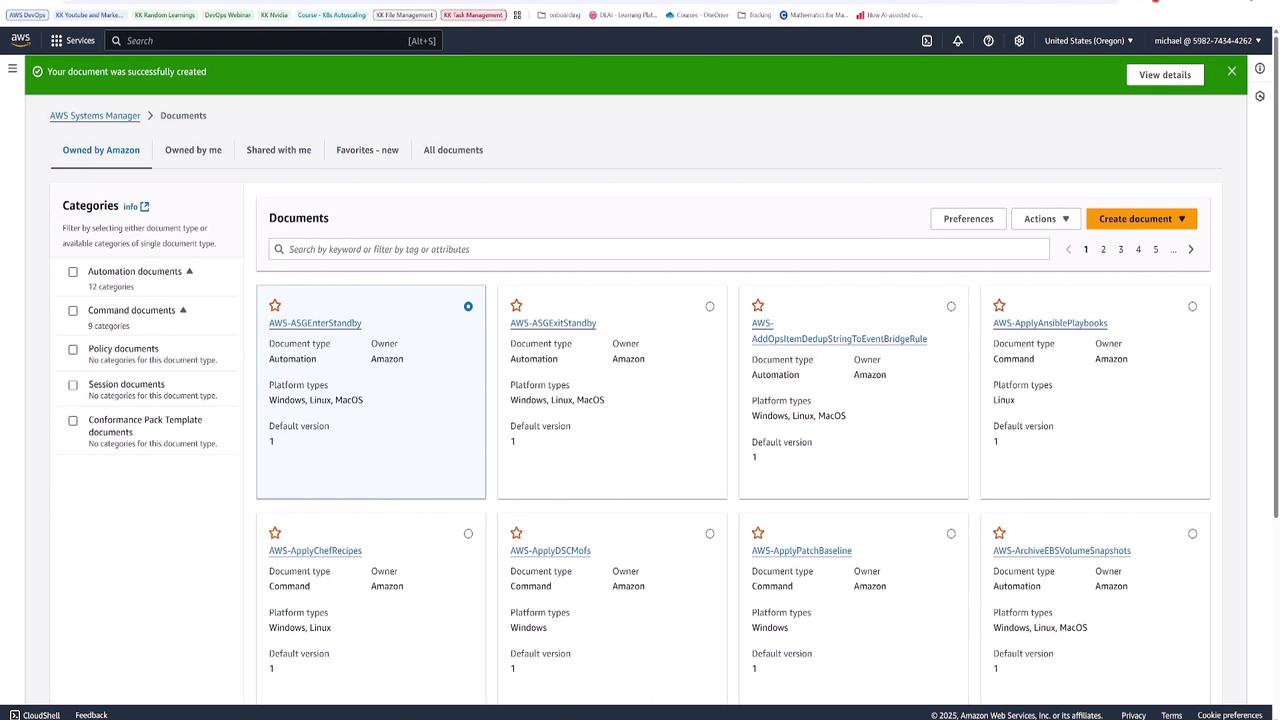
Executing the Automation Runbook
To execute the runbook, select Execute Automation. When prompted, provide the instance ID for the automation demo instance. The execution process includes:
- Verifying the current instance state.
- Stopping the instance.
- Waiting for the stop confirmation.
- Retrieving the root volume ID.
- Creating the snapshot.
- Restarting and verifying the instance.
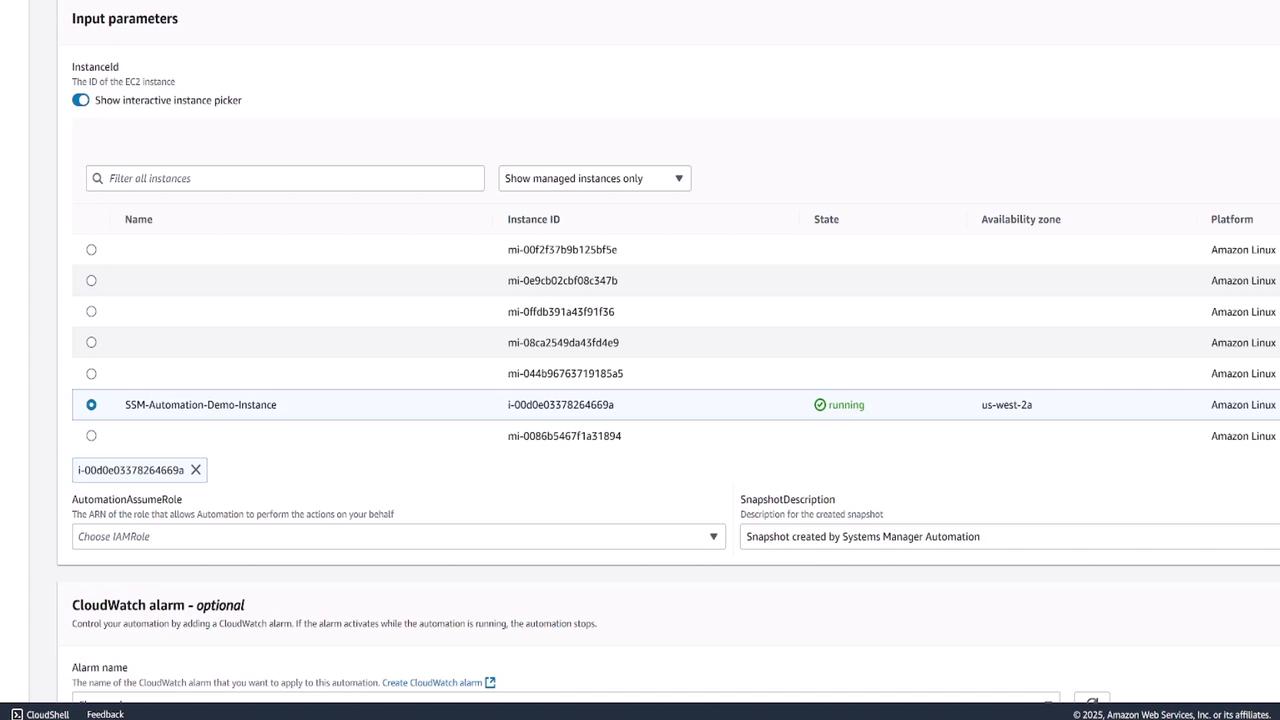
Monitor the automation's progress through the execution detail page:
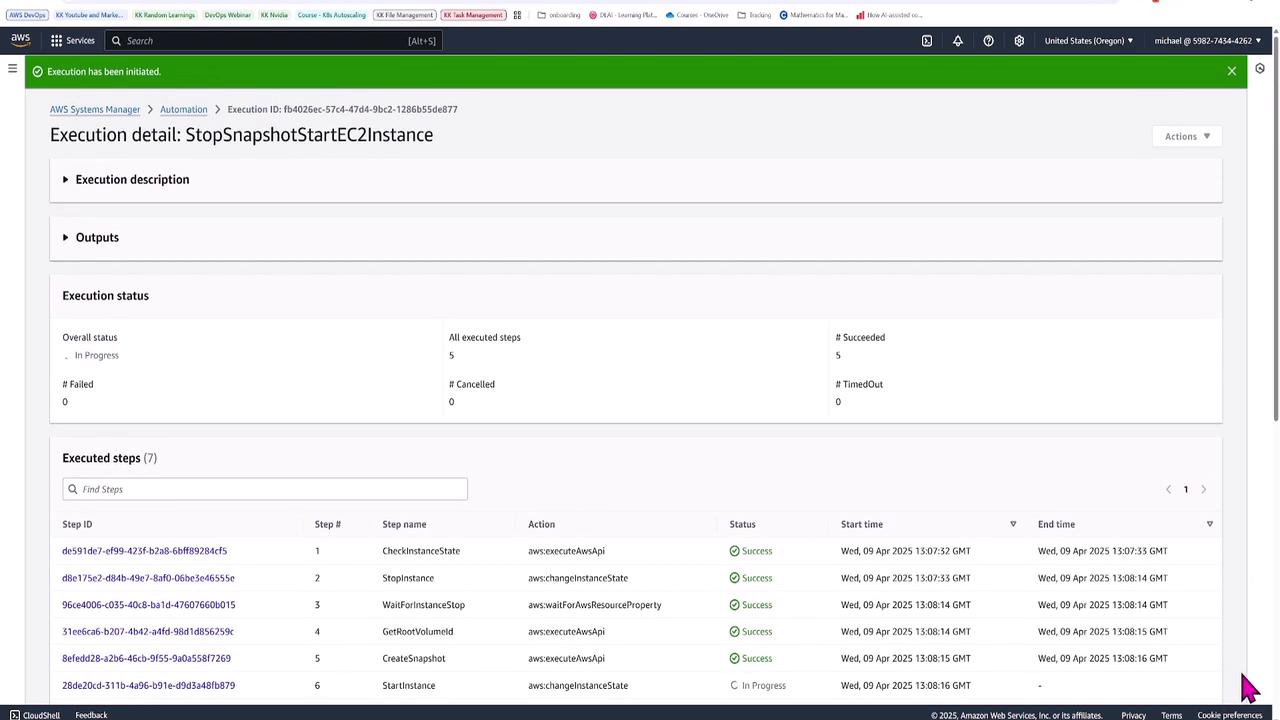
Note
This automation document showcases how to chain multiple steps—even calling additional documents—to efficiently manage EC2 instances. For complex workflows, advanced features like concurrency control and input parameter variations are available.
After successful execution, you can verify that the instance is running and a snapshot has been created for the EC2 root volume. In this demo, the snapshot for the 8 GB volume is approximately 1.65 GB and shows a completed status.
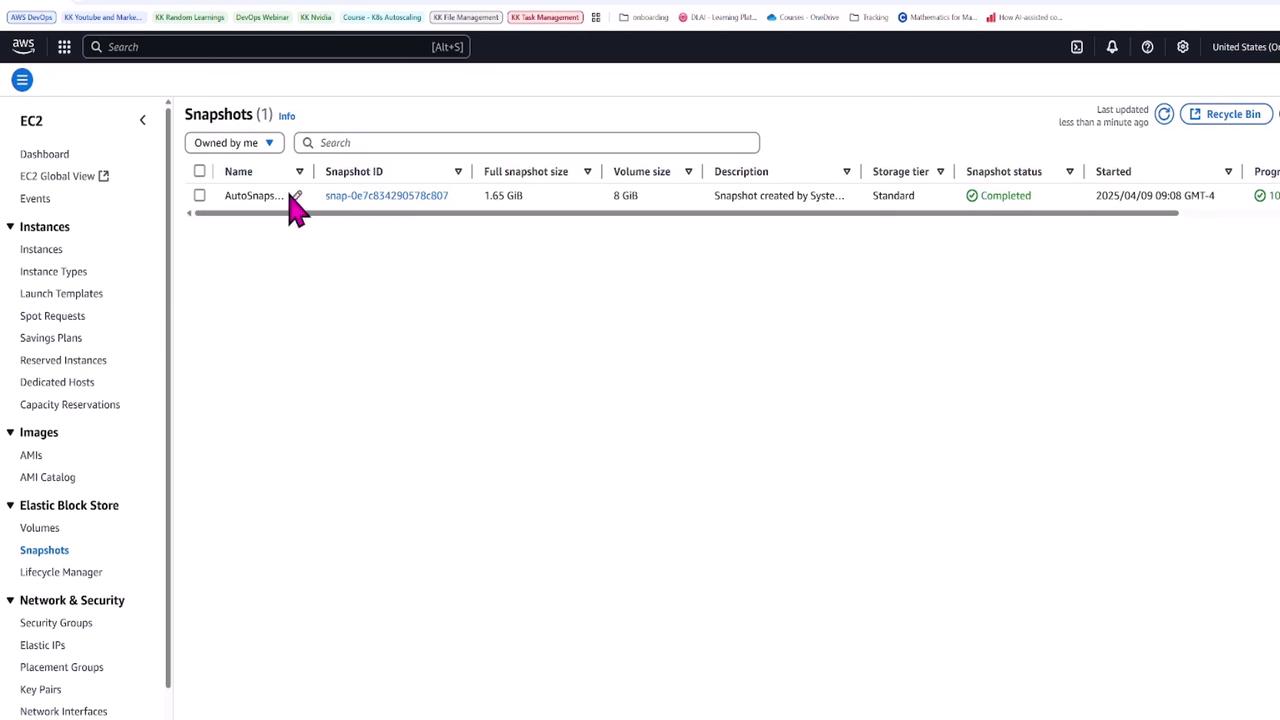
Complete YAML for the Automation Document
Below is the full YAML version of the automation document used in this lesson:
description: Stop an EC2 instance, create a snapshot, and start it again
schemaVersion: '0.3'
assumeRole: '{{AutomationAssumeRole}}'
parameters:
instanceId:
type: String
description: The ID of the EC2 instance
default: 'i-0a1b2c3d4e5f6g7h8'
snapshotDescription:
type: String
description: A description for the snapshot
default: ''
mainSteps:
- action: CheckInstanceState
name: CheckInstanceState
inputs:
InstanceId: '{{instanceId}}'
Api: DescribeInstanceStatus
IncludeAllInstances: true
- action: StopInstance
name: StopInstance
inputs:
InstanceId: '{{instanceId}}'
- action: CreateSnapshot
name: CreateSnapshot
inputs:
InstanceId: '{{instanceId}}'
Description: '{{snapshotDescription}}'
- action: WaitForInstanceStop
name: WaitForInstanceStop
inputs:
InstanceId: '{{instanceId}}'
This lesson provides a detailed overview of using SSM Automation to manage EC2 configurations and snapshots. Though simple in this demo, automation documents can be extended to handle far more intricate scenarios.
Happy automating, and stay tuned for more lessons on advanced AWS management techniques!
Watch Video
Watch video content